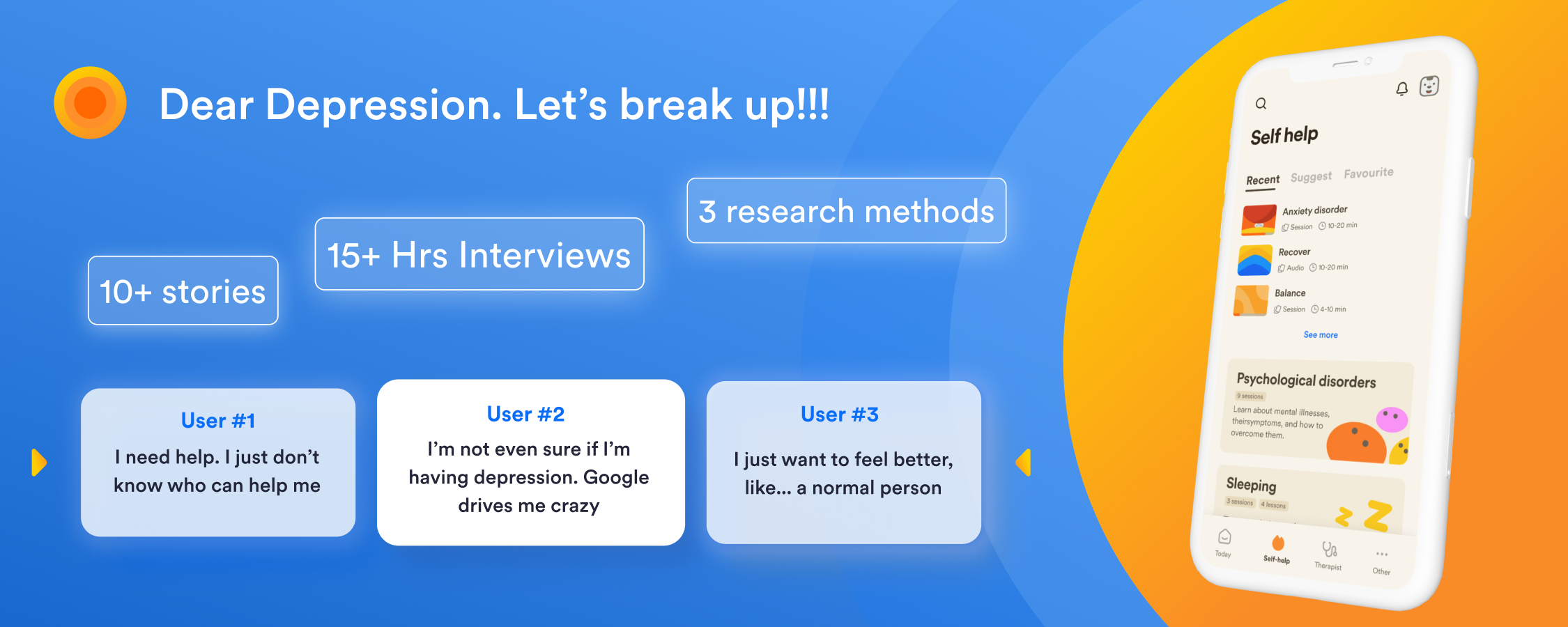
Case Study - Tomorrow
ROLE
DESIGNER & RESEARCHER
PLATFORM
MOBILE
MEMBER
ALTHEA NGUYEN – TRUNG HIEU
TIMELIME
AUG 2022 – OCT 2022
Overview
Tomorrow is a Product Design project that my Squad has been working on for the past 3 months with the desire to solve the problem of helping people who are suffering from, or are at risk of depression to be aware of its nature, and access appropriate treatment methods early.
This topic may be familiar to developed countries where mental health is a top priority. However, in Vietnam, the rate of psychiatrists is too low compared to the population size. Data from the World Health Organization (WHO) in 2014 showed that for every 100,000 people in Vietnam, there were only 0.91 psychiatrists, much lower than the WHO recommended rate (10 / 100,000), among the lowest in the world.
Therefore, the team wants to build an App product to help the target audience be aware of this depression, know their status, and know what to do next.
Problem Statement
Help young people in Vietnam become aware of the impact of depression so they can access the right treatment methods early to avoid relapse and recurrence.
Target audience
Our group’s target is people who have experienced depression for the first time, corresponding to the young audience.
Based on some reports and statistics, we have determined that the main customer group is young people between the ages of 18-25. This is also the age group with the highest rate of first-time depression.
Design Process

Research method
To hone in on the exact problem faced by locals in Vietnam, competitive analysis, desk research and user interviews were carried out.
Market & competitor analysis
The need for psychological counseling has actually existed for a long time in Vietnam. In addition to hospitals, there are also many centers and facilities outside that provide psychological counseling services such as:
In addition, there are also centers that provide online counseling services such as:
An app, a product, a technological solution to deal with depression is quite new in Vietnam, but it is not that no one has ever done it. Although the number of products in Vietnam is still quite limited in quantity and diversity compared to foreign countries, it is still evidence that there is still a demand in the market. Some products in the Vietnamese market that we have access to:
Some apps in Vietnam:
- Wellcare: App to book online doctor consultation
- Carota: App to assess psychology, book psychological consultation, provide information.
- Sandex Care: App to book psychological consultation
- Onky: App to book online doctor consultation
- Betterhelp: App to book online psychological counseling
- 7cups: App to book people to chat and advise
- Headspace: App to teach meditation
- Youper: App to connect, chat and provide psychological counseling
- Reflexio: App to support writing a diary, tracking emotions
- MoodNotes: App to track mood, emotions, heart rate

Interview
To gain a deeper understanding of depression, we will conduct interviews in two phases:
Phase 1: Exploratory Interviews
In this initial phase, we will engage in unstructured conversations with psychology experts and students. This approach will allow us to gather broad insights and foundational knowledge about depression from those with academic and professional experience. These conversations will help us frame our research and develop more focused questions for the next phase.
Phase 2: Focused Interviews
Equipped with the knowledge from the first phase, we will conduct semi-structured interviews with individuals who have personal experience with depression. We will use a pre-prepared set of questions to guide these interviews, ensuring we gather specific information and confirm key insights. This structured approach will help us delve deeper into the lived experiences of those affected by depression, while still allowing for open-ended responses.

Define
Persona

Experience journey map
Having identified our target audience (persona), we’ll map the journey of individuals experiencing depression. This map will track their experiences from the moment they begin to explore their mental health, seeking self-improvement and well-being. It will encompass their behaviors, emotions, and motivations, including their potential interactions – or lack thereof – with our product.
By creating this User Journey Map, we aim to:
- Deeply understand our users: Gaining insights into their needs and challenges.
- Identify their needs: Pinpointing the root causes of their problems.
- Empathize with their struggles: Understanding their emotional responses to these challenges.
- Discover their solutions: Learning how they seek to address their mental health.
This map will be a crucial tool in guiding the development of a product that truly resonates with our target audience and effectively supports their journey towards better mental health.

Solution
Self-healing module
The purpose of this module is for users to understand more about their own condition, the underlying cause and how to improve their current condition. Furthermore, we also want them to increase their awareness of mental illnesses that they may have and proactively prevent or seek help from psychologists (if they feel necessary)
The challenge of this feature lies in how users can access the necessary information, suitable for themselves without spending too much effort. Moreover, once they have found the right content, they can still view and absorb it easily, without pressure.
Our team determines that this module is to convey information and content, so our team’s **approach** to this part is as follows:
1. Estimate the amount of content to convey
2. Determine the forms of content communication
3. Group content
4. How users can absorb better

- Therapy
This is a feature that our team determined would be important, but due to limited resources and time, we will not implement this part in the program.
This module will be a place where users can connect with psychologists, and psychological consultations will also be conducted here.
Some opportunities that we saw in this module when researching competitors as well as interviewing psychologists:
Providing additional information such as a description of how a psychological consultation will take place, things to note such as the psychologist’s approach / treatment is very important in their decision making
Due to the nature of psychological examination, there should be no social relationship between the psychologist and the patient, so the connection, information and scheduling are being done through a third party.
During the psychological examination, there are also exercises such as drawing or writing a diary. The current barrier is also a difficulty in the exchange process if this person wants to share with the psychologist.
When a person has been examined by a psychologist, when they have to switch to a new psychologist, they often have to start from the beginning with the new psychologist. This is quite time-consuming because many problems have to be repeated.
Journey for people who experience depression
With a large amount of information and spread across many issues, the team wants to promote personalization of the experience. A roadmap built on the current situation of the user is the idea that the team wants to implement.
This journey will provide and arrange lessons, exercises, depression tests, … in an order that is suitable for the user’s current situation. As for providing appropriate content, the app will have a set of questions to assess the user’s current situation. This set of questions will appear in the onboarding section, when the user first enters the app, the user can skip and complete it later.
Users can see the image of the content, the name of the content and the progress of completing the content. Users can also click directly to go to the content.
Here, when proposing this journey solution, the team faces challenges.
This screen must be really simple and intuitive, otherwise it will take too much cognitive load from the user and confuse them.
Personalized experience is good but it will be a disaster if it is personalized wrongly… Therefore, in addition to the pressure to make the filter question set good enough, to avoid the case of the content not being suitable for the user, there must be a way for the user to change this pre-set content.
The filter question set requires enough detail to find the user’s problem but must not take too much of their time and effort to complete
For the first problem, the team solved it by pursuing a minimalist style while the second problem is a more headache. In the future, the team believes that a comprehensive tracking solution and changes to suit the user after a certain fixed period of time is an optimal solution if it ensures that the content after the change is more suitable for the user than before. But that is really difficult and requires a lot of research time, so the team just wants to simply stop at the MVP version, that is, when the user needs to change the route, they click on the “3 dots” to choose to change the route, then the initial screening review will be redone.

Question set
This is essentially a solution to a problem that arose from a previous solution – the roadmap feature. The challenges of this question set:
– The questions are highly specialized.
– It is necessary to balance between simplicity so that users can do it quickly and without much effort, and complexity enough to assess the current status of the user.
Once again, our team encountered the problem of content and expertise. Similar to the self-healing feature, our team also decided to research and analyze other competitors. The competitors our team chose to research were Minddoc, Wysa, Amaha, Youper.
The research results show that each competitor’s questionnaire has different content, but in terms of topics, they have many things in common and only focus on a few topics such as emotions, thoughts, sleep, relationships, moods, … And all are questions about the level that the person is experiencing (usually 4-5 levels) although the way of asking may be different. The group also found that this level of asking is quite similar to the screening tests for depression and other mental illnesses such as DASS-21 (21 questions), …
From that result, the group assumed that the App’s screening test will be in the form of a level of questions, the number of which is around 10 questions (average of competitors). The content may change in the future but it does not affect the current design of the app too much. The remaining thing is to choose how to ask so that the user feels most comfortable and saves the most time.
According to the research of competitors, the group found 3 ways of asking. After brainstorming to see if there was a better way, the group could not find any better way than these three, so they decided to analyze only these three ways and choose the best one.

Next step
While significant progress has been made in the past three months, our team acknowledges that this project requires further development. Following the UXMP program, we will prioritize the following steps:
- Expert Consultation: We will engage with more experts to refine our content and ensure its accuracy and relevance.
- User Testing: Through rigorous testing, we will validate user needs and gather valuable insights to guide further development.
- Feature Implementation: We will focus on deploying key features, such as self-assessment tests, chatbots, and emotion-tracking tools.
Based on the outcomes of these activities, we will evaluate the project’s potential and determine next steps. Our long-term vision is to integrate James Wallman’s STORIES framework, emphasizing Offline and Relationship aspects. This may involve features that mitigate the negative impacts of social media, encourage users to connect with nature, and foster stronger relationships with loved ones.
Thanks for reading thus far! Do get in touch with me on LinkedIn for any kind of feedback, suggestions or collaborations!
